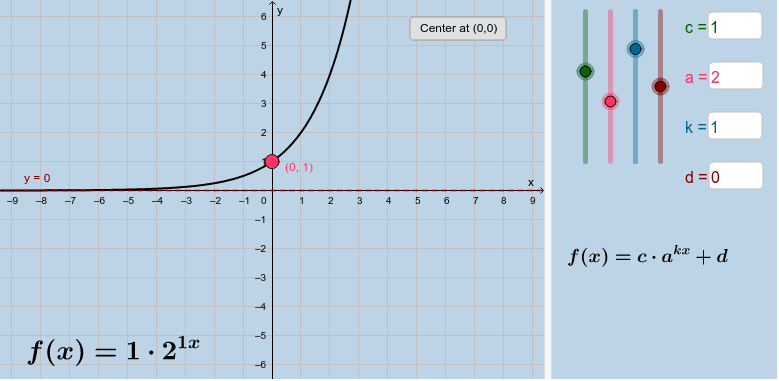Exponential Functions: Graphs
The following applet displays the graph of the exponential function [math]f\left(x\right)=c\cdot a^{kx}+d[/math]. [br]Interact with the applet below for a few minutes, then answer the questions that follow.
[b][color=#000000]Questions:[/color][/b][br][br][color=#000000]1) How does the parameter [/color][color=#cc0000][b]a[/b][/color] [color=#000000]affect the graph of the exponential function? Explain. [br] What happens if [/color][color=#cc0000][b]a > 1[/b][/color][color=#000000] and [/color][color=#1e84cc][b]k > 0[/b][/color][color=#000000]? What happens if [/color][color=#cc0000][b]a < 1[/b][/color][color=#000000] and [/color][color=#1e84cc][b]k > 0[/b][/color][color=#000000]? [br][br][/color][color=#000000]2) How does the parameter [/color][b][color=#1e84cc]k[/color][/b][color=#000000] affect the graph? Explain. [br] If you need a hint, refer back to [url=https://www.geogebra.org/m/HJvZSUna]this worksheet[/url]. [br][br][/color][color=#000000]3) What does the parameter [/color][color=#980000][b]d[/b][/color][color=#000000] do the graph? Explain. [br][br][/color][color=#000000]4) Suppose [/color][color=#cc0000][b]a < 1[/b][/color][color=#000000]. [br] Given this constraint, is it possible to get the graph of this exponential function to look the way it does[br] when [/color][color=#cc0000][b]a > 1[/b][/color][color=#000000] and [/color][color=#1e84cc][b]k > 0[/b][/color][color=#000000]? Explain. [/color]
Differentiation from first principles
Differentiation from first principles
What happens to the gradient of the chord line as PN approaches 0?
